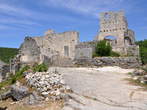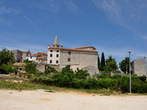Rovinj with its surroundings is known for many natural and cultural sights that attract many domestic and foreign visitors. Among them, the most popular are the picturesque town of Rovinj, Lim Bay, Kanfanar, Dvigrad and Bale.
Rovinj is one of the most beautiful and picturesque towns on the Adriatic coast. The old part lies on the peninsula and has two ports - south and north. The old town lies on an islet, which was in the 18th century connected to the mainland by an embankment. At the highest point stands the church dedicated to Saint Euphemia. The church houses a late antique stone sarcophagus of Saint Euphemia and a series of valuable objects and paintings. In the square next to the harbor is the famous Baroque Balbi arch on the site of the city gate, a former 17th-century magistrate and a clock tower.
Lim Bay is one of the most beautiful on the Adriatic. About 10 kilometers long and 600 meters wide, it bit into the mainland between Rovinj and Vrsar. It is actually a submerged part of Limska draga. For centuries, this karst basin was the main direction in which all traffic from the western coast of Istria to the hinterland took place. The canyon sides of the coast, overgrown with macchia, descend more than 100 meters to the sea. Today, Lim Bay is an interesting tourist attraction, and in the upper part of the bay there are shellfish farms and fish farms. Dvigrad spreads in the middle of Limska draga.
It is the largest abandoned urban settlement in the interior of Istria, as evidenced by the remains of many houses protected by double walls and castle gates. The last inhabitants left the settlement at the beginning of the 17th century and founded Kanfanar on the hill. Kanfanar lies at the junction of the arms of the Istrian Y. At the beginning of the 18th century, an early Gothic stone pulpit from the 13th century with a relief of St. Sophia with two seats in its hands, some wooden statues and a painted door from the 16th century were transferred from the Dvigrad basilica to the parish church of St. Sylvester. Bale is about 15 kilometers away from Rovinj.
It is spread on a hill in the area of a prehistoric castle and a later Roman castrum. In the church of St. Julian from 1880, built on the site of an old church from the 9th century, fragments of plaited and early Romanesque sculpture and a stone sarcophagus have been preserved.







 from 24 €
from 24 €